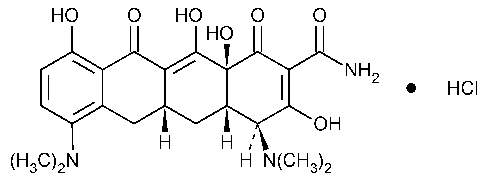Minocycline Hydrochloride
C23H27N3O7·HCl
493.95
2-Naphthacenecarboxamide,4,7-bis(dimethylamino)-1,4,4a,5,5a,6,11,12a-octahydro-3,10,12,12a-tetrahydroxy-1,11dioxo-,monohydrochloride,[4S-(4a,4aa,5aa,12aa)]-.
4,7-Bis(dimethylamino)-1,4,4a,5,5a,6,11,12a-octahydro-3,10,12,12a-tetrahydroxy-1,11-dioxo-2-naphthacenecarboxamide monohydrochloride [13614-98-7].
2-Naphthacenecarboxamide,4,7-bis(dimethylamino)-1,4,4a,5,5a,6,11,12a-octahydro-3,10,12,12a-tetrahydroxy-1,11dioxo-,monohydrochloride,[4S-(4a,4aa,5aa,12aa)]-.
4,7-Bis(dimethylamino)-1,4,4a,5,5a,6,11,12a-octahydro-3,10,12,12a-tetrahydroxy-1,11-dioxo-2-naphthacenecarboxamide monohydrochloride [13614-98-7].
»Minocycline Hydrochloride contains the equivalent of not less than 890µg and not more than 950µg of minocycline (C23H27N3O7)per mg,calculated on the anhydrous basis.
Packaging and storage—
Preserve in tight containers,protected from light.
Labeling—
Where it is intended for use in preparing injectable dosage forms,the label states that it is sterile or must be subjected to further processing during the preparation of injectable dosage forms.
Identification,Infrared Absorption á197Kñ:
previously dried at 100 for 2hours.
for 2hours.
Crystallinity á695ñ:
meets the requirements.
pHá791ñ:
between 3.5and 4.5,in a solution containing the equivalent of 10mg of minocycline per mL.
Water,Method Iá921ñ:
between 4.3%and 8.0%.
Residue on ignition á281ñ:
not more than 0.15%.
Heavy metals,Method IIá231ñ:
0.005%.
Chromatographic purity—
Mobile phase,Resolution solution,and Chromatographic system—
Proceed as directed in the Assay.
Test solution 1—
Transfer about 25mg of Minocycline Hydrochloride,accurately weighed,to a 100-mLvolumetric flask,dilute with water to volume,and mix.Protect this solution from light,store in a refrigerator,and use within 3hours.
Test solution 2—
Transfer 1.0mLof Test solution 1to a 50-mLvolumetric flask,dilute with water to volume,and mix.Protect this solution from light,store in a refrigerator,and use within 3hours.
Test solution 3—
Transfer 6.0mLof Test solution 2to a 10-mLvolumetric flask,dilute with water to volume,and mix.Protect this solution from light,store in a refrigerator,and use within 3hours.
Procedure—
Separately inject equal volumes (about 20µL)of Test solution 1,Test solution 2,and Test solution 3into the chromatograph,record the chromatograms,and measure the areas for all the peaks.[NOTE—Record the chromatogram of Test solution 1for a period of time that is about 2.6times the retention time of minocycline.]Calculate the percentage of epiminocycline in the portion of Minocycline Hydrochloride taken by the formula:
1.2rE1/rM3,
in which rE1is the peak response for epiminocycline obtained from Test solution 1;and rM3is the peak response for minocycline obtained from Test solution 3.Not more than 1.2%is found.Calculate the total percentage of impurities other than epiminocycline in the portion of Minocycline Hydrochloride taken by the formula:
2rs/rM2,
in which rsis the sum of the responses of all impurity peaks other than epiminocycline obtained from Test solution 1;and rM2is the peak response for minocycline obtained from Test solution 2.Not more than 2.0%of other impurities is found.
Other requirements—
Where the label states that Minocycline Hydrochloride is sterile,it meets the requirements for Sterility Tests á71ñand for Bacterial endotoxinsunder Minocycline for Injection.Where the label states that Minocycline Hydrochloride must be subjected to further processing during the preparation of injectable dosage forms,it meets the requirements for Bacterial endotoxinsunder Minocycline for Injection.
Assay—
Mobile phase—
Prepare a mixture of 0.2Mammonium oxalate,0.01Medetate disodium,dimethylformamide,and tetrahydrofuran (600:180:120:80).Adjust with ammonium hydroxide to a pHof 7.2,and pass through a filter having a 0.5-µm or finer porosity.Make adjustments if necessary (see System Suitabilityunder Chromatography á621ñ).
Standard preparation—
Dissolve an accurately weighed quantity of USP Minocycline Hydrochloride RSin water to obtain a solution having a known concentration of about 500µg of minocycline (C23H27N3O7)per mL.Use this solution within 3hours.
Resolution solution—
Transfer 10mg of USP Minocycline Hydrochloride RSto a 25-mLvolumetric flask,add 20mLof 0.2Mammonium oxalate,and swirl to dissolve.Heat on a water bath at 60 for 180minutes,and allow to cool.Dilute with water to volume,and mix.
for 180minutes,and allow to cool.Dilute with water to volume,and mix.
Assay preparation—
Transfer an accurately weighed quantity of Minocycline Hydrochloride,equivalent to about 50mg of minocycline (C23H27N3O7),to a 100-mLvolumetric flask,add water to volume,and mix.
Chromatographic system (see Chromatography á621ñ)—
The liquid chromatograph is equipped with a 280-nm detector and a 4.6-mm ×25-cm column that contains 5-µm packing L1,and is maintained at a constant temperature of about 40 .The flow rate is about 1.5mLper minute.Chromatograph the Standard preparation,and record the peak responses as directed for Procedure:the capacity factor,k¢,is not less than 5.0and not more than 11.5;the tailing factor for the analyte peak is not less than 0.9and not more than 2.0;and the relative standard deviation for replicate injections is not more than 2.0%.Chromatograph the Resolution solutionand record the peak responses as directed for Procedure:the relative retention times are about 0.7for epiminocycline and 1.0for minocycline;and the resolution,R,between epiminocycline and minocycline is not less than 4.6.
.The flow rate is about 1.5mLper minute.Chromatograph the Standard preparation,and record the peak responses as directed for Procedure:the capacity factor,k¢,is not less than 5.0and not more than 11.5;the tailing factor for the analyte peak is not less than 0.9and not more than 2.0;and the relative standard deviation for replicate injections is not more than 2.0%.Chromatograph the Resolution solutionand record the peak responses as directed for Procedure:the relative retention times are about 0.7for epiminocycline and 1.0for minocycline;and the resolution,R,between epiminocycline and minocycline is not less than 4.6.
Procedure—
Separately inject equal volumes (about 20µL)of the Standard preparationand the Assay preparationinto the chromatograph,record the chromatograms,and measure the responses for the major peaks.Calculate the quantity,in µg per mg,of minocycline (C23H27N3O7),in the portion of Minocycline Hydrochloride taken by the formula:
100(C/W)(rU/rS),
in which Cis the concentration,in µg per mL,of minocycline (C23H27N3O7)in the Standard preparation;Wis the weight,in mg,of Minocycline Hydrochloride taken;and rUand rSare the peak responses obtained from the Assay preparationand the Standard preparation,respectively.
Auxiliary Information—
Staff Liaison:William W.Wright,Ph.D.,Scientific Fellow
Expert Committee:(PA7)Pharmaceutical Analysis 7
USP28–NF23Page 1298
Pharmacopeial Forum:Volume No.28(3)Page 770
Phone Number:1-301-816-8335
